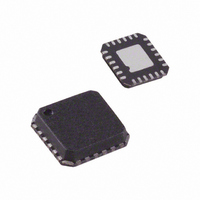ADN2871ACPZ-RL7 Analog Devices Inc, ADN2871ACPZ-RL7 Datasheet - Page 13

ADN2871ACPZ-RL7
Manufacturer Part Number
ADN2871ACPZ-RL7
Description
IC,Laser Diode/LED Driver,LLCC,24PIN,PLASTIC
Manufacturer
Analog Devices Inc
Type
Laser Diode Driver (Fiber Optic)r
Datasheet
1.ADN2871ACPZ-RL.pdf
(20 pages)
Specifications of ADN2871ACPZ-RL7
Data Rate
4.25Gbps
Number Of Channels
1
Voltage - Supply
3 V ~ 3.6 V
Current - Supply
32mA
Current - Modulation
90mA
Current - Bias
100mA
Operating Temperature
-40°C ~ 85°C
Package / Case
24-VFQFN, CSP Exposed Pad
Mounting Type
Surface Mount
Lead Free Status / RoHS Status
Lead free / RoHS Compliant
THEORY OF OPERATION
Laser diodes have a current-in to light-out transfer function, as
shown in Figure 28. Two key characteristics of this transfer
function are the threshold current, Ith, and the slope in the
linear region beyond the threshold current, referred to as the
slope efficiency, LI.
LASER CONTROL
Typically, laser threshold current and slope efficiency are both
functions of temperature. For FP- and DFB-type lasers, the
threshold current increases and the slope efficiency decreases
with increasing temperature. In addition, these parameters vary
as the laser ages. To maintain a constant optical average power
and a constant optical extinction ratio over temperature and
laser lifetime, it is necessary to vary the applied electrical bias
current and modulation current to compensate for the changing
LI characteristics of the laser.
Average Power Control Loop (APCL)
The APCL compensates for changes in Ith and LI by varying
IBIAS. Average power control is performed by measuring the
MPD current, I
MPD. This is not a problem because the APCL is required to
respond to the average current from the MPD.
Extinction Ratio (ER) Control
ER control is implemented by adjusting the modulation current.
Temperature calibration is required to adjust the modulation
current to compensate for variations of the laser characteristics
with temperature.
P
P
P1
AV
O
MPD
Figure 28. Laser Transfer Function
. This current is bandwidth-limited by the
ER =
P
AV
=
P1
P
P1 + P
Ith
O
2
O
ΔI
CURRENT
ΔP
LI =
ΔP
ΔI
Rev. A | Page 13 of 20
CONTROL METHODS
The ADN2871 has two methods for setting the average power
(P
extinction ratio can be voltage-set using the output of a
microcontroller’s voltage DACs to provide controlled reference
voltages, PAVREF and ERREF. Alternatively, the average power
and extinction ratio can be resistor-set using potentiometers at
the PAVSET and ERSET pins, respectively.
VOLTAGE SETPOINT CALIBRATION
The ADN2871 allows interface to a microcontroller for both
control and monitoring (see Figure 29). The average power and
extinction ratio can be set using the microcontroller DACs to
provide controlled reference voltages, PAVREF and ERREF.
where:
R
P
R
I
In voltage setpoint mode, R
with a 1% tolerance and a temperature coefficient of 50 ppm/°C.
Power-On Sequence in Voltage Setpoint Mode
Note that during power-up, there is an internal sequence that
allows 25 ms before enabling the alarms; therefore, the
customer must ensure that the voltages for PAVREF and ERREF
are active within 20 ms after ramp-up of the power supply. If the
PARREF and ERREF voltages are supplied after 25 ms, then the
part alarms and FAIL is activated.
MOD
AV
SP
PAV
AV
is the optical responsivity (in amperes per watt).
is the average power required.
) and extinction ratio (ER). The average power and
= R
is the modulation current.
PAVREF = P
ERREF
ERSET
= 1 kΩ.
=
I
MOD
AV
× R
100
×
R
SP
ERSET
× R
PAV
PAV
and R
ERSET
must be 1 kΩ resistors
ADN2871
(V)
(V)












